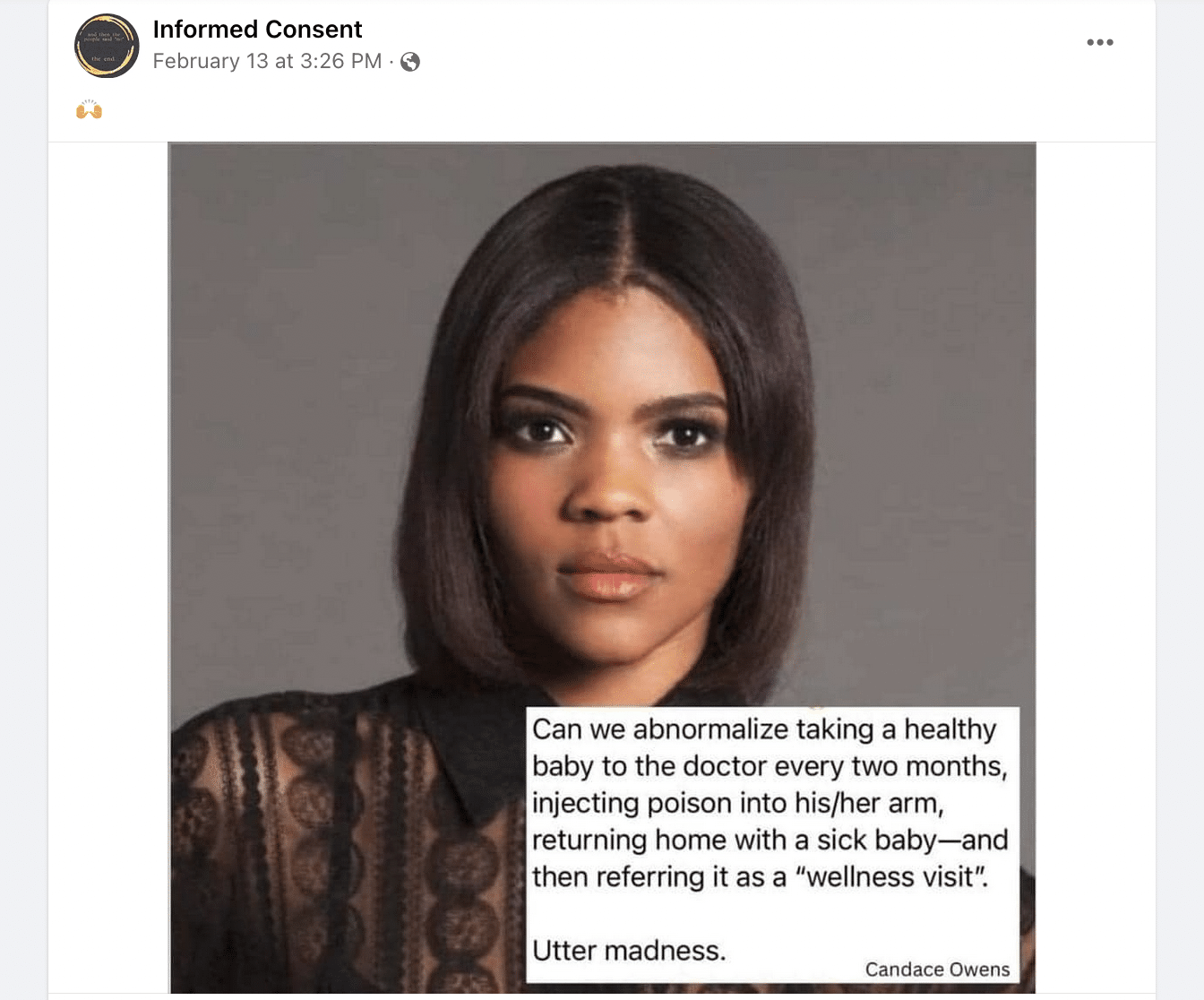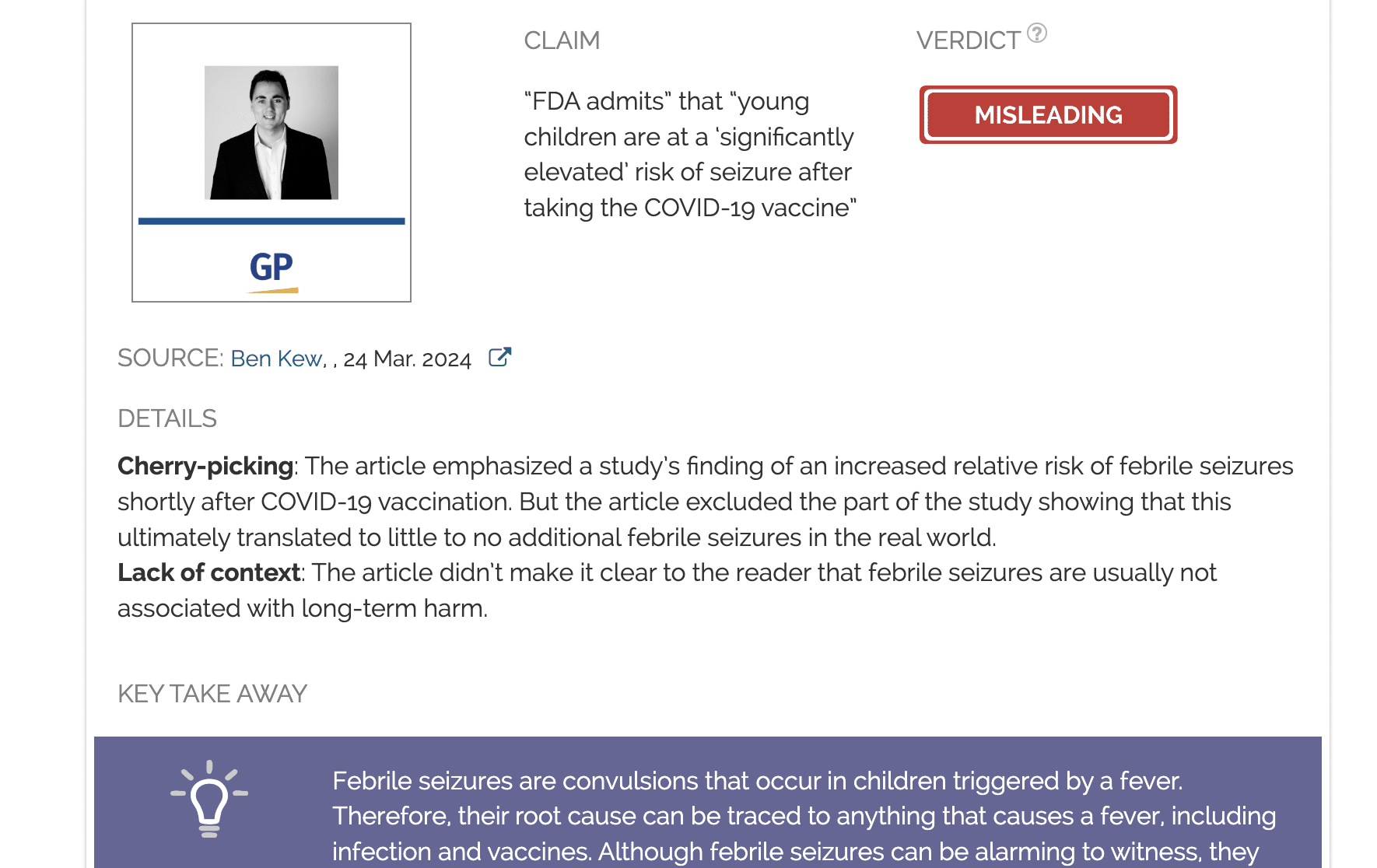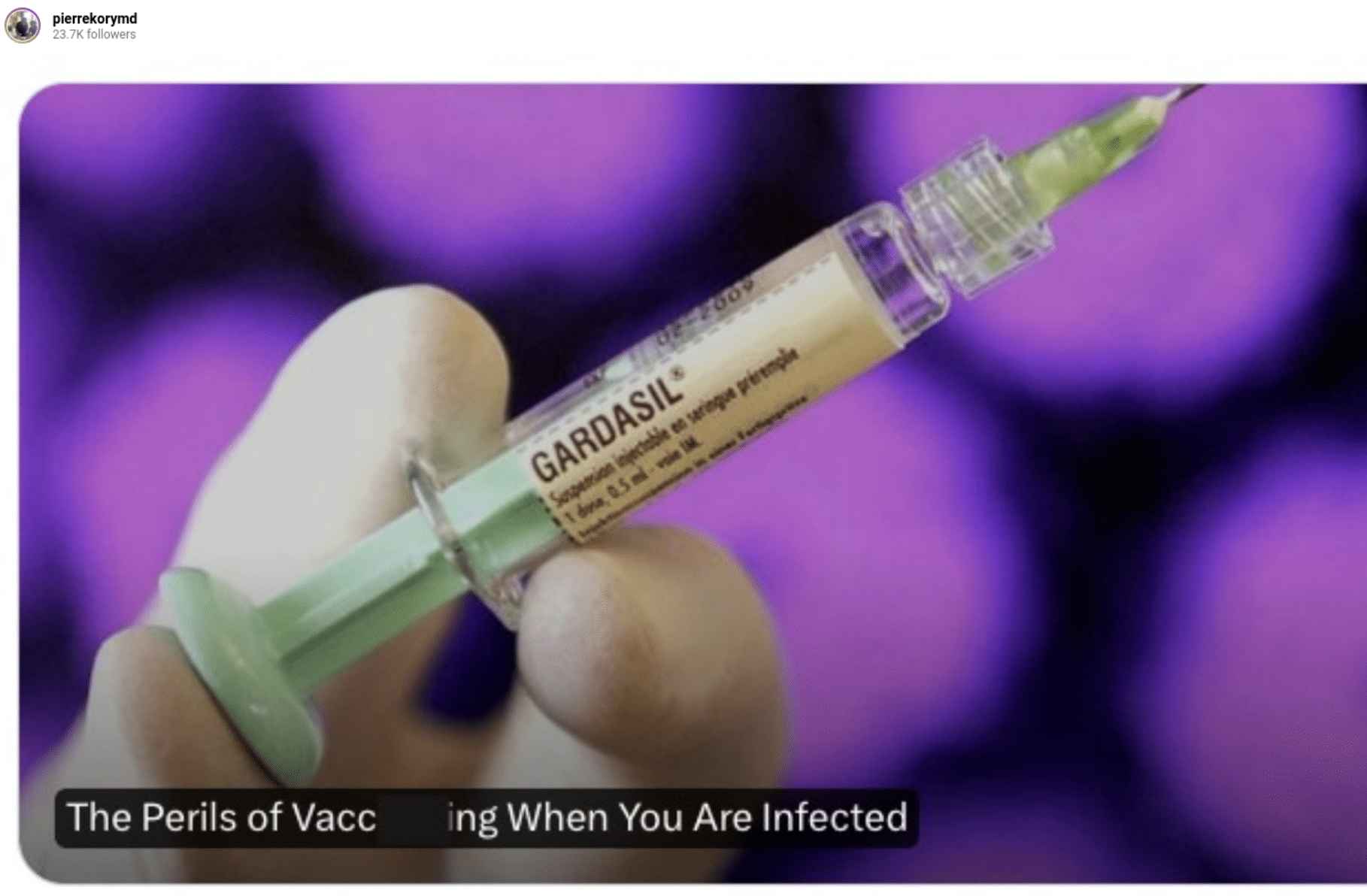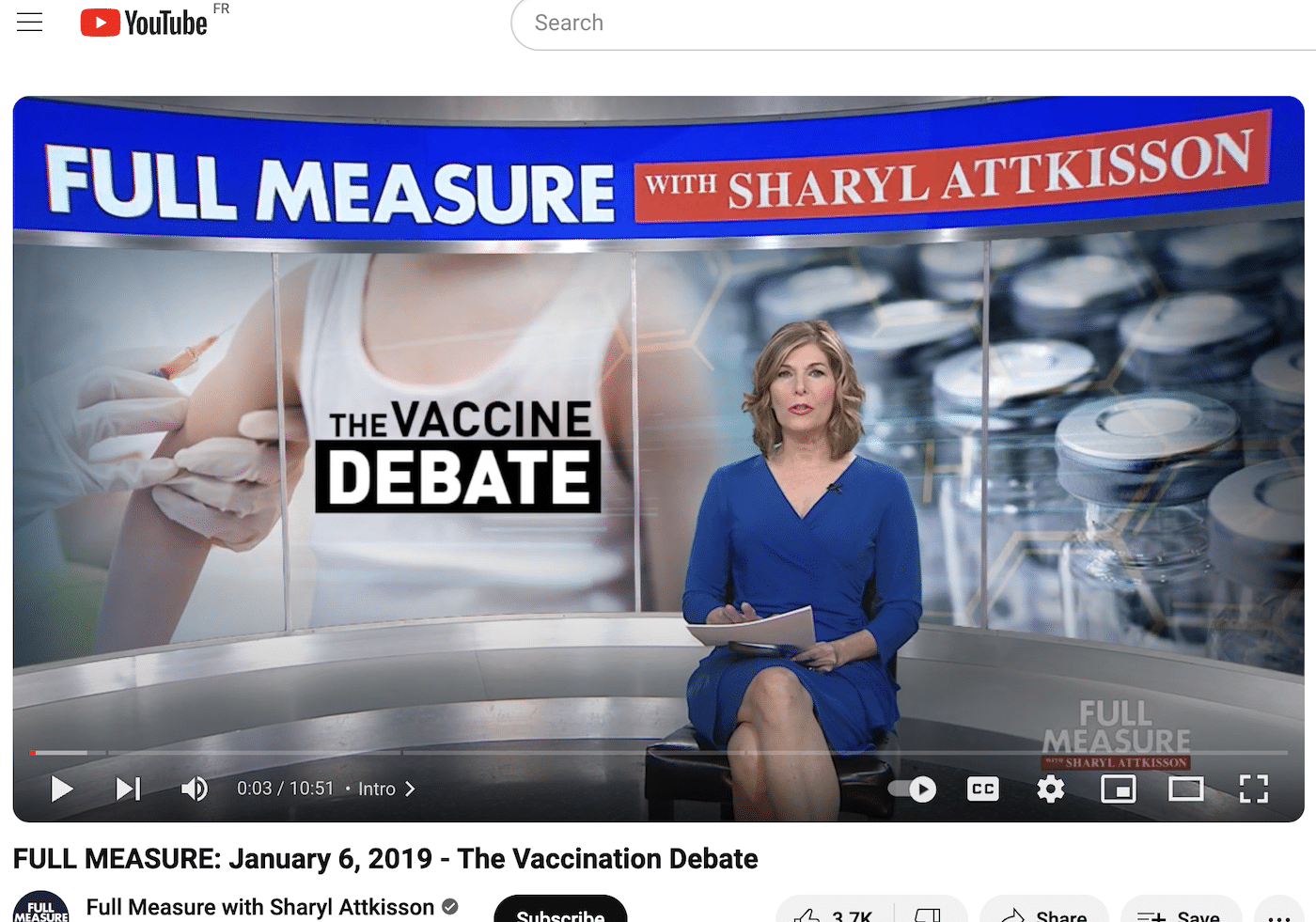- Health
Childhood vaccines are an important protection against preventable diseases, not “poison” as claimed by Candace Owens
Key takeaway
Vaccines are thoroughly tested for safety, and common side effects, such as soreness, are signs of the body developing protective immunity. Childhood vaccination has saved hundreds of thousands of lives, and lower uptake can lead to disease outbreaks. Toxic chemicals, such as mercury, aluminum, and formaldehyde, are either in a safe form, found in only trace quantities that are safe, or have been removed entirely.
Reviewed content

Verdict:
Claim:
Doctors are ‘injecting poison’ into babies every two months.
Verdict detail
Factually inaccurate: Childhood vaccines have saved hundreds of thousands of lives in the U.S. alone and save millions every year globally. Describing them as poison that turns a healthy baby into a sick one contradicts the scientific evidence showing the protection that vaccines provide against illness.
Imprecise: A poison is a substance that injures health or destroys life when introduced into the body. While vaccines can contain trace amounts of chemicals that could be toxic in much higher quantities, they have been thoroughly tested and shown to be safe. The same is true of practically any medication—taken in extreme quantities, they can be harmful, but when used as prescribed, they are highly safe and beneficial.
Full Claim
‘Can we abnormalize taking a healthy baby to the doctor every two months, injecting poison into his/her arm, returning home with a sick baby—and then referring [to] it as a “wellness visit”. Utter madness.’
Review
Social media posts have repeatedly spread misleading claims about the safety of the contents of vaccines. These posts typically misrepresent the nature of individual vaccine components and disregard the safety and benefits of vaccination.
In an X/Twitter post published on 12 February 2024, political commentator and talk show host Candace Owens described childhood vaccines as poison. This post was viewed over 2.7 million times on X alone and was reshared on Facebook.
Owens has previously made several inaccurate and misleading claims about vaccines. This included an inaccurate claim a month earlier that vaccines had caused an increase in childhood cancer.
Owens’s recent claim not only misrepresents the nature of routine vaccinations but also undermines the critical role they play in maintaining public health. In response, this article aims to debunk the misconceptions, explain the purpose and safety of routine vaccinations, and highlight the benefits of wellness visits.
Vaccines and their components have been tested and shown to be safe
Before any vaccine is approved for public use, it undergoes rigorous testing in clinical trials to ensure its safety and efficacy. After approval, vaccines are continuously monitored for adverse effects through systems like the Vaccine Adverse Event Reporting System (VAERS) in the U.S., where anyone can report suspected vaccine reactions. The U.S. Centers for Disease Control and Prevention (CDC) also has other programs to actively monitor and research vaccine safety, like the Vaccine Safety Datalink . Similar surveillance systems are also in place in many other countries.
It’s normal for vaccines to cause mild side effects, such as soreness at the injection site or a low-grade fever. These are indications that the body is building protection against the disease. Common side effects include:
- Soreness, redness, or swelling in the area the vaccine was given
- Fatigue
- Low fever
- Headache
- Achy joints or muscles
- Chills
Serious complications are extremely rare, and the benefits of vaccination in preventing disease far outweigh the risks.
Owens described vaccination as “injecting poison”, which is in line with many anti-vaccination claims that mislead about the safety of vaccine ingredients. Health Feedback has addressed several of these claims previously:
- No mercury or aluminum is present in vaccines
- Vaccines do not cause mercury toxicity or autism
- Scientific evidence demonstrates that vaccines are safe and effective
- Claim that ingredients in flu vaccine are known neurotoxins found to be incorrect
- Vaccine ingredients are safe, not linked to encephalopathy
- Article claiming flu vaccine causes serious illness and death is misleading and inaccurate
Below, we briefly summarize the key points addressing three of the most commonly cited components in such claims:
Mercury
A mercury-containing compound called thimerosal was used in vaccines as a preservative and antibacterial. Preservatives in vaccines are important for avoiding risks associated with bacterial contamination, as the Bundaberg disaster that occurred in 1928 in Queensland, Australia clearly illustrated.
Thimerosal is quickly degraded and eliminated by the body, unlike other forms of mercury, meaning that it does not accumulate in the body to reach toxic levels.
Speaking to Health Feedback in 2019, James D. Cherry , a professor of pediatrics at the David Geffen School of Medicine, University of California Los Angeles, said:
“Ethylmercury, which is from thimerosal, is very safe, and it degrades so that there’s no problem whatsoever. The problem is that regular mercury is very toxic. Methylmercury, which contaminates fish for example, is also toxic. But ethylmercury acts as a preservative and also as an antibacterial, so it prevents vaccines from being contaminated with bad bacteria.”
Although there was no evidence of harm caused by the low levels of thimerosal in vaccines, it was reduced or eliminated from vaccines in 1999. Since 2001, there has been no thimerosal in childhood vaccines in the United States, except some influenza vaccines, although thimerosal-free versions are available.
Aluminum
Aluminum isn’t used in its elemental form in vaccines but in the form of aluminum salts, which act as adjuvants. These have been used in vaccines for more than 70 years. Adjuvants heighten the immune response to the vaccine and enhance protection against infection. While excessive amounts of adjuvants can trigger side effects, the levels used in vaccines are low and safe.
Cherry said:
“There is aluminum salt present in killed vaccines, such as the present DTaP and Tdap vaccines, but it’s a very good adjuvant and it’s been in killed vaccines from the very beginning. The amount and the actual aluminum salt may vary with vaccines. The key thing is that too much aluminum would give you abscesses at the site of vaccination, but no present killed vaccine has excessive amounts. In live vaccines there’s no aluminum at all.”
Formaldehyde
Formaldehyde is a chemical used very early in the manufacturing process of some vaccines to kill or inactivate the toxins from bacteria or viruses. The formaldehyde is then diluted during the rest of the manufacturing process, but extremely low quantities may remain that are insufficient to cause toxicity. The quantity in any individual vaccine is about 1,500 times smaller than the amount in a two-month-old infant. This means there’s no plausible reason for the formaldehyde in vaccines to pose a safety concern.
Speaking to Health Feedback in 2019, Neal Halsey, professor emeritus at Johns Hopkins Bloomberg School of Public Health, said:
“Some vaccines do contain very small (trace) amounts of formaldehyde, which is a natural product produced by all mammalian cells. The trace amounts in some vaccines are residuals from the manufacturing process. In high concentrations, formaldehyde is toxic to cells and organisms. It is used to kill some of the organisms that are used to make vaccines and then purification removes all but a trace of the formaldehyde. The trace amounts that are left as a residual in vaccines are considered to have no additive effect to the naturally produced formaldehyde in our bodies.”
The vaccine schedule protects against preventable diseases
The childhood vaccine schedule is designed to protect against various infectious diseases. Contrary to the misleading claim of “injecting poison”, vaccines are carefully formulated to train the immune system to recognize and fight specific pathogens without causing the disease.
Babies are at high risk of severe complications or even death from infectious diseases. This is why vaccines for some diseases are prioritized at an early age. While newborns inherit a temporary immunity to certain diseases through antibodies received from their mothers, this protection is short-lived. Furthermore, this temporary immunity does not protect against many other serious diseases, such as diphtheria, whooping cough (pertussis), polio, tetanus, hepatitis B, and Haemophilus influenzae type b (Hib). Therefore, it is crucial to vaccinate babies early—before they have a chance to encounter these diseases.
During the first twelve months, babies in the U.S. typically receive the following vaccines:
- Hepatitis B
- Rotavirus
- Diphtheria, tetanus & acellular pertussis (DTaP)
- Haemophilus influenzae type b (Hib)
- Pneumococcal conjugate
- Polio
- COVID-19
- Influenza
- Measles, mumps, rubella
- Varicella
The schedule can also include a vaccine against respiratory syncytial virus (RSV), depending on the mother’s vaccination status.
Many of these vaccines require multiple doses in order to maintain long-lasting immune protection. This helps to inform the dosage schedule, leaving long enough periods between doses for maximum efficacy.
These vaccines are known to effectively reduce the risk of serious illnesses. For diphtheria, Haemophilus influenzae type b, measles, mumps, polio, and rubella, the vaccines reduce the incidence of the disease by 100%[1]. Childhood vaccination was estimated to have prevented 21 million hospitalizations and 732,000 deaths in the U.S. between 1994 and 2013[2]. According to the CDC, about four million deaths are prevented each year globally because of childhood vaccinations.
The American Academy of Pediatrics (AAP) describes how the vaccine schedule is determined:
“The timing for each dose of a vaccine is based on 2 factors. First, scientists determine the age when the body’s immune system will provide optimal protection after vaccination. Second, that information is balanced with the need to provide protection to infants, children and adolescents at the earliest possible time based on the highest age of risk for that disease.”
The Advisory Committee on Immunization Practices meets three times a year to evaluate the vaccine schedule and recommendations. The CDC then sets the schedule and publishes the changes.
Falling rates of childhood vaccination have led to concerns about the risk of increased outbreaks of preventable diseases[3]. 2019 saw the greatest number of measles cases in the U.S. since 1992, and the majority of cases were among children who were not vaccinated against the disease[4]. More recently, a measles outbreak in Ohio in late 2022 led to 36 unvaccinated children being hospitalized.
Wellness visits cover many aspects of a baby’s development
Wellness visits, or well-child visits, are comprehensive health checks that monitor a child’s growth and development, as well as offer vaccinations. These visits include preventive care, developmental screenings, and guidance on nutrition and safety, supporting the child’s health and wellbeing.
The AAP recommends well-child visits for babies and young toddlers at three to five days old and then at 1, 2, 4, 6, 9, 12, 15, 18, 24, and 30 months.
Conclusion
Misrepresenting routine vaccinations and wellness visits does a disservice to public health and individual wellbeing. The evidence overwhelmingly supports the safety and efficacy of vaccines in preventing serious diseases. By relying on scientific facts and consulting healthcare professionals, individuals can make informed decisions that protect the health of children and the broader community.
REFERENCES
- 1 – Talbird et al. (2022) Impact of Routine Childhood Immunization in Reducing Vaccine-Preventable Diseases in the United States. Pediatrics.
- 2 – Whitney et al. (2014) Benefits from immunization during the vaccines for children program era – United States, 1994-2013. Morbidity and Mortality Weekly Report.
- 3 – Seither et al. (2023) Vaccination Coverage with Selected Vaccines and Exemption Rates Among Children in Kindergarten — United States, 2021–22 School Year. Morbidity and Mortality Weekly Report.
- 4 – Patel et al. (2019) National Update on Measles Cases and Outbreaks — United States, January 1–October 1, 2019. Morbidity and Mortality Weekly Report.



